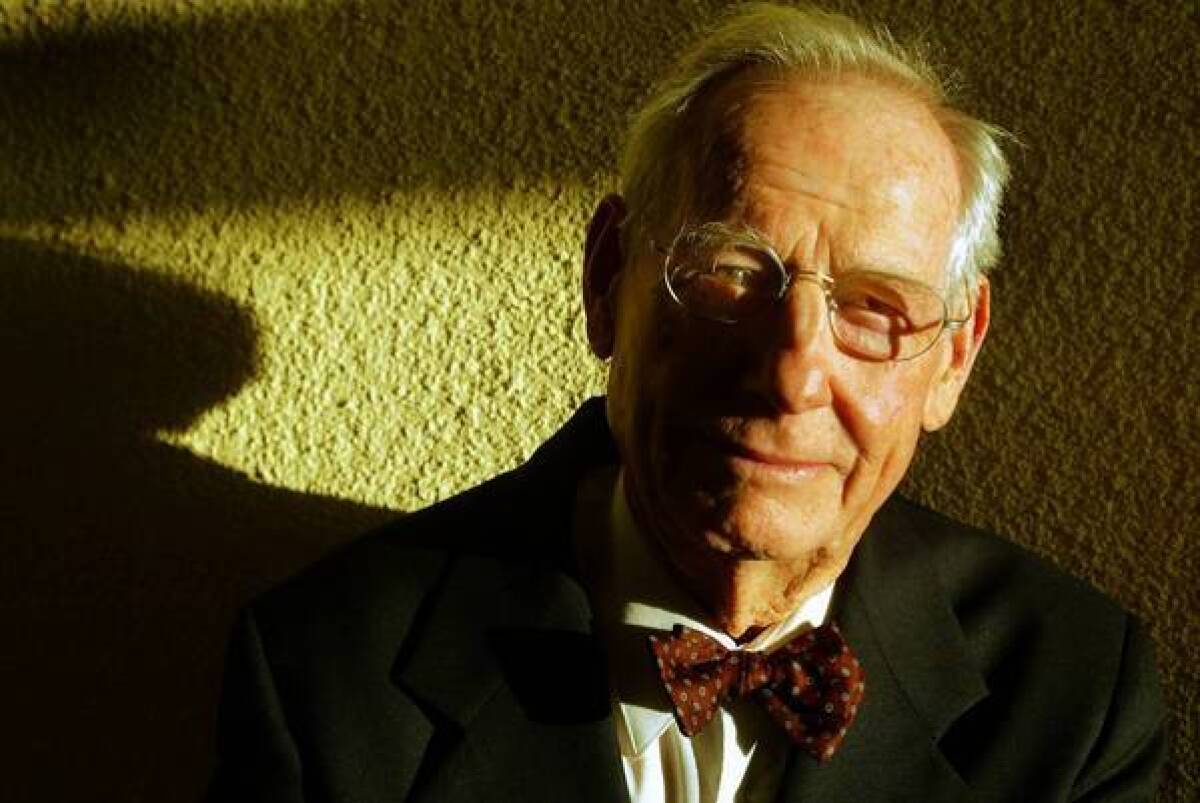Wayne Thiebaud examines a still life

The De Young Museum in San Francisco has borrowed paintings from dozens of collectors and museums to put together its Richard Diebenkorn exhibition, focusing on the late artist’s years in Berkeley from 1953 to 1966.
One lender is Wayne Thiebaud, the 92-year-old master of hand-painted Pop famous for his candy-colored richly textured images of pies, cakes and ice-cream treats.
He loaned a Diebenkorn still life from 1955 that features a bottle and spoon against a sea of competing blues for the show, which runs through Sept. 29.
PHOTOS: Arts and culture in pictures by The Times
We called Thiebaud at his studio in Sacramento to learn more about the untitled painting.
How did you come to own this work?
My son who passed away [Paul Thiebaud, 1960-2010] managed to buy it for us. We had a couple Diebenkorn etchings and drawings, so we were happy to have the chance to acquire it. It was near the end of Paul’s time as a dealer, so we haven’t had it that long.
I thought maybe you traded your own work for it.
We did trade works before — there was a time in 1964 when we were both working with Kathan Brown at Crown Point Press. He was doing etchings and produced a wonderful book called “41 Etchings.” I did a book of 17 etchings called “Delights” … I think he took some palm trees, a little etching, from me.... We also have an early “Ocean Park,” one of his very, very early images from that series, halfway between a drawing and a painting with some gouache and charcoal.
What appeals to you about the still life?
One of the enduring aspects of the painting is its freshness, directness. It’s not fussed with or modified. The painting is quite a beautiful direct encounter.
ART: Can you guess the high price?
I’m looking at a reproduction of the painting and you can make out a bottle, a spoon and matches. But I’m not sure about the round shape on the right side — a stone fruit?
I think it’s a lemon. The nice thing about Dick’s paintings is that they are quite equivocal. We are partially responsible for finishing and identifying things, participating in the painting itself by using our own sense of imagination and looking slowly. We are always asking the question: What is that, or how is that functioning? He leaves that nice incompleteness always there.
Right, it’s not a classic still life. There’s great tension between the objects, which are traditionally supposed to be the focus, and the background, which has such substance and texture.
It’s like he’s interested in overlooked organizational units. In other words, he’s looking aside onto a kitchen instead of directly at the subject matter that would say kitchen or table setting. Unlike, say, Chardin he is not doing these setup still-life arrangements. The way he leaves the scissors open in one painting or places a knife between two halves of fruit in another — it’s like a still life still forming itself.
I also love the colors in the painting.
One of the greatest things about Dick’s work is his use of color, which is spectral or prismatic. There are always at least two yellows, two reds, two blues, so that the warm and cool alternation or juxtaposition of the colors enlivens the work. He uses a warm reddish blue and then a greenish blue and a purplish one, and they tend to develop what’s called color chords, much like the three notes on a piano. His color is quite marvelously connected to a tradition of color. That’s why he collected things like Indian miniatures and makes you think of painters like Matisse and Bonnard.
PHOTOS: Best art museum exhibits of 2012 | Christopher Knight
The painting now hangs at the De Young, but did you live with it before then?
Yes, we lived with it for several years. We move things around a lot in our house, and I try to avoid looking at my own work.
Where did it hang most recently?
In the front entranceway. You could serve a person a nice drink right away.
So you see the bottle as alcohol?
For some reason I think of the bottle as some kind of spirit, but it could as well be turpentine — something that is used in painting. It’s a strange type of bottle, not like a wine bottle. It’s almost slightly medical.
How well did you get to know Diebenkorn?
I first met him maybe 40 years ago. I didn’t really live in the Bay Area at the time; I was in Sacramento and very enamored of his work and influenced by it. We became friends, and I have been to his house in L.A. and Healdsburg for dinner. And we got together in San Francisco. I just enjoyed talking to him.
What was he like as a conversationalist?
Dick was a hesitant conversationalist, in some ways like his paintings. He would start and then stop, draw back and then start again. Dick was suspicious of what he called the headlong, where you start and go on no matter what happened. He was careful, analytical, very bright. He loved poetry, and we talked about that and of course other painters.
You once said: “I steal from the Japanese; I steal from the Chinese; I steal from de Kooning; I steal from Diebenkorn — and try not to insult them at the same time.” What in your own work connects back to Diebenkorn most directly?
The subject matter for one, the wonderful city paintings he did. I was very much influenced by those. But also the structural aspect of his paintings, his use of space and that sense of equivocation, his willingness to make something unfinished seem finished. The work also has this sense of intimacy: He was not interested in fancy subject matter but making ordinary subject matters special.
More to Read
The biggest entertainment stories
Get our big stories about Hollywood, film, television, music, arts, culture and more right in your inbox as soon as they publish.
You may occasionally receive promotional content from the Los Angeles Times.










